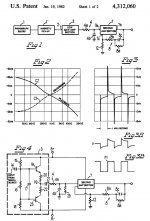Recently purchased a preamp made by robert. The patent of which is here
Preamplifier for phonograph pickup - GRODINSKY; ROBERT
and a schematic here
Preamplifier for phonograph pickup
any thoughts on this topology, in particular the phono section, which is what i'd like to use it for. Can anyone explain what the design is similar to and/or if it seems like a well thought out and good sounding phono preamp?
Preamplifier for phonograph pickup - GRODINSKY; ROBERT
and a schematic here
Preamplifier for phonograph pickup
any thoughts on this topology, in particular the phono section, which is what i'd like to use it for. Can anyone explain what the design is similar to and/or if it seems like a well thought out and good sounding phono preamp?
A patent for this? There must be hundreds of phono preamps based on a similar concept. Don't waste any time on it. Plenty more interesting and better justified topologies today.
Grodinsky's "thing" was buffering the input so that the cartridge sees a load that does not vary with frequency or level. That's a laudable goal for MM pickups having high load sensitivity. With buffering, one can also minimize input capacitance, which can be an issue for some (but by no means all) MM cartridges. The tradeoff was extra noise, which can be minimized, but is still inevitable.
There were other ways to achieve this in those days and, as analog_sa says, even more ways to do it now.
There were other ways to achieve this in those days and, as analog_sa says, even more ways to do it now.
A patent for this? There must be hundreds of phono preamps based on a similar concept. Don't waste any time on it. Plenty more interesting and better justified topologies today.
I dunno, his first stage is low gain, most others seem to have high gain first stages ... and he makes an interesting argument for active and passive sections of the RIAA ...


"
...
Abstract:
The preamplifier has a first stage or section of low or unity gain, such as an emitter-follower circuit, which also isolates the preamplifier from impedance variations of the cartridge, and with a bandwidth for greater than the audio range to reproduce signals with a very high amplitude, rapidly changing wavefront without slew or amplitude overload distortion. A RIAA high frequency de-emphasis network is coupled between this first stage or section and a second amplifier section. A RIAA low frequency emphasis network is preferably placed in a negative feedback circuit of the latter amplifier section where the feedback circuit does not contain the high frequency components filtered out by the high frequency de-emphasis network. The second amplifier section need not have the bandwidth of the first amplifier stage or section.
Inventors: Grodinsky, Robert (4448 W. Howard St., Skokie, IL, 60076)
Application Number: 06/033380
Publication Date: 01/19/1982
Filing Date: 04/26/1979
...
"
from:
Preamplifier for phonograph pickup - GRODINSKY; ROBERT
😎
Last edited:
most others seem to have high gain first stages ...
There's a reason for that- noise. I can think of other preamps of that era which also used a buffered input, but the tradeoff was still there.
In reality, the input stage used in the Grodinsky's preamp was not a follower, it had voltage gain.
Keep in mind that you are dealing with signal power to noise power ratio. An emitter follower has no voltage gain but it does have power gain so you don't degrade SNR that badly.
Finally located the article which explains why the emitter follower first stage doesn't have a really bad effect on SNR.
Input Stages for Amplifiers Connected to Very-Low Or Very-High Impedance Signal Sources - ResearchGate
Input Stages for Amplifiers Connected to Very-Low Or Very-High Impedance Signal Sources - ResearchGate
well I bought the thing and will see how it sounds.....I'll be using it with a shureV15II and a micro acoustics 2002e....I don't know if they will benefit from his approach or not.....
How did this turn out for you?
I've got a RGR Model 4-2 as well and I love the way it sounds. Do you have any other docs on it?
Best Regards,
Bill
well I bought the thing and will see how it sounds.....I'll be using it with a shureV15II and a micro acoustics 2002e....I don't know if they will benefit from his approach or not.....
I've got a RGR Model 4-2 as well and I love the way it sounds. Do you have any other docs on it?
Best Regards,
Bill
This is off topic but I recently found this circuit in my files. I also couldn't figure out how Mr. Grodinsky got a patent. Using a common collector input stage is not new and splitting the RIAA compensation is not new. This circuit was a kit from a company named Transiteck in 1970. It was their universal preamplifier and was advertised as having about .01 percent distortion and 72 dB SNR WRT 1 millivolt. Good specks for the time.
Attachments
I appreciate the reply...
My RGR is fronting a hafler dh-500 that's been modified with upgraded driver boards and new bigger filter caps. It drives BA Lynnfield VR30's. It sounds great. I like the RGR pre. It's been a very pleasant surprise actually.
Best regards,
Bill
My RGR is fronting a hafler dh-500 that's been modified with upgraded driver boards and new bigger filter caps. It drives BA Lynnfield VR30's. It sounds great. I like the RGR pre. It's been a very pleasant surprise actually.
Best regards,
Bill
- Status
- Not open for further replies.
- Home
- Source & Line
- Analogue Source
- Grodinsky Robert phono section